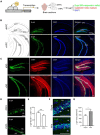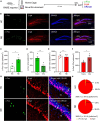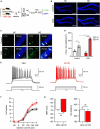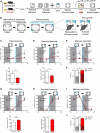Retinoic acid modulation of granule cell activity and spatial discrimination in the adult hippocampus
- PMID: 38694537
- PMCID: PMC11061364
- DOI: 10.3389/fncel.2024.1379438
Retinoic acid modulation of granule cell activity and spatial discrimination in the adult hippocampus
Abstract
Retinoic acid (RA), derived from vitamin A (retinol), plays a crucial role in modulating neuroplasticity within the adult brain. Perturbations in RA signaling have been associated with memory impairments, underscoring the necessity to elucidate RA's influence on neuronal activity, particularly within the hippocampus. In this study, we investigated the cell type and sub-regional distribution of RA-responsive granule cells (GCs) in the mouse hippocampus and delineated their properties. We discovered that RA-responsive GCs tend to exhibit a muted response to environmental novelty, typically remaining inactive. Interestingly, chronic dietary depletion of RA leads to an abnormal increase in GC activation evoked by a novel environment, an effect that is replicated by the localized application of an RA receptor beta (RARβ) antagonist. Furthermore, our study shows that prolonged RA deficiency impairs spatial discrimination-a cognitive function reliant on the hippocampus-with such impairments being reversible with RA replenishment. In summary, our findings significantly contribute to a better understanding of RA's role in regulating adult hippocampal neuroplasticity and cognitive functions.
Keywords: dentate gyrus; granule cells; hippocampal neuroplasticity; retinoic acid; spatial discrimination; vitamin A.
Copyright © 2024 Yeo, Park, Kim, Rah, Shin, Oh, Jang, Lee, Yoon and Oh.
Conflict of interest statement
The authors declare that the research was conducted in the absence of any commercial or financial relationships that could be construed as a potential conflict of interest.
Figures




Similar articles
-
Differential regulation of spontaneous and evoked inhibitory synaptic transmission in somatosensory cortex by retinoic acid.Synapse. 2016 Nov;70(11):445-52. doi: 10.1002/syn.21921. Epub 2016 Jul 12. Synapse. 2016. PMID: 27348405 Free PMC article.
-
Retinoic acid modulates intrahippocampal levels of corticosterone in middle-aged mice: consequences on hippocampal plasticity and contextual memory.Front Aging Neurosci. 2014 Feb 7;6:6. doi: 10.3389/fnagi.2014.00006. eCollection 2014. Front Aging Neurosci. 2014. PMID: 24570662 Free PMC article.
-
Vitamin A deficiency impairs contextual fear memory in rats: Abnormalities in the glucocorticoid pathway.J Neuroendocrinol. 2019 Nov;31(11):e12802. doi: 10.1111/jne.12802. Epub 2019 Nov 13. J Neuroendocrinol. 2019. PMID: 31613407
-
Vitamin A and Retinoic Acid in Cognition and Cognitive Disease.Annu Rev Nutr. 2020 Sep 23;40:247-272. doi: 10.1146/annurev-nutr-122319-034227. Annu Rev Nutr. 2020. PMID: 32966186 Review.
-
Synaptic retinoic acid signaling and homeostatic synaptic plasticity.Neuropharmacology. 2014 Mar;78:3-12. doi: 10.1016/j.neuropharm.2012.12.004. Epub 2012 Dec 25. Neuropharmacology. 2014. PMID: 23270606 Free PMC article. Review.
References
-
- Basu R., Whitley S. K., Bhaumik S., Zindl C. L., Schoeb T. R., Benveniste E. N., et al. (2015). IL-1 signaling modulates activation of Stat transcription factors to antagonize retinoic acid signaling and control the TH 17 cell–iT reg cell balance. Nat. Immunol. 16 286–295. 10.1038/ni.3099 - DOI - PMC - PubMed
LinkOut - more resources
Full Text Sources
Molecular Biology Databases
Miscellaneous

